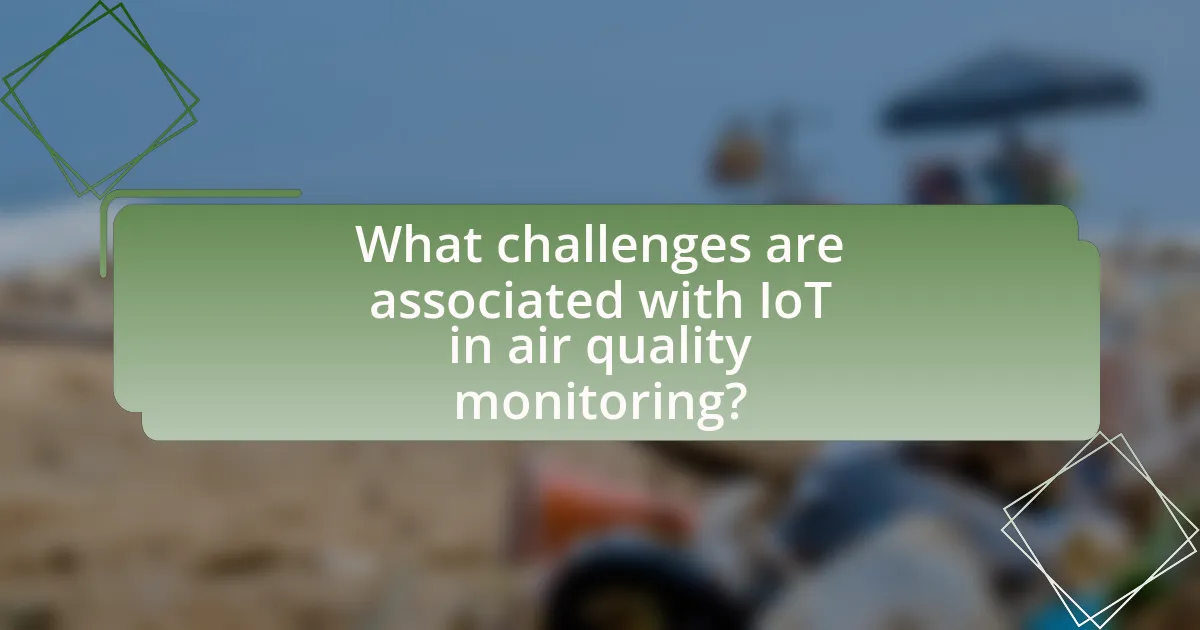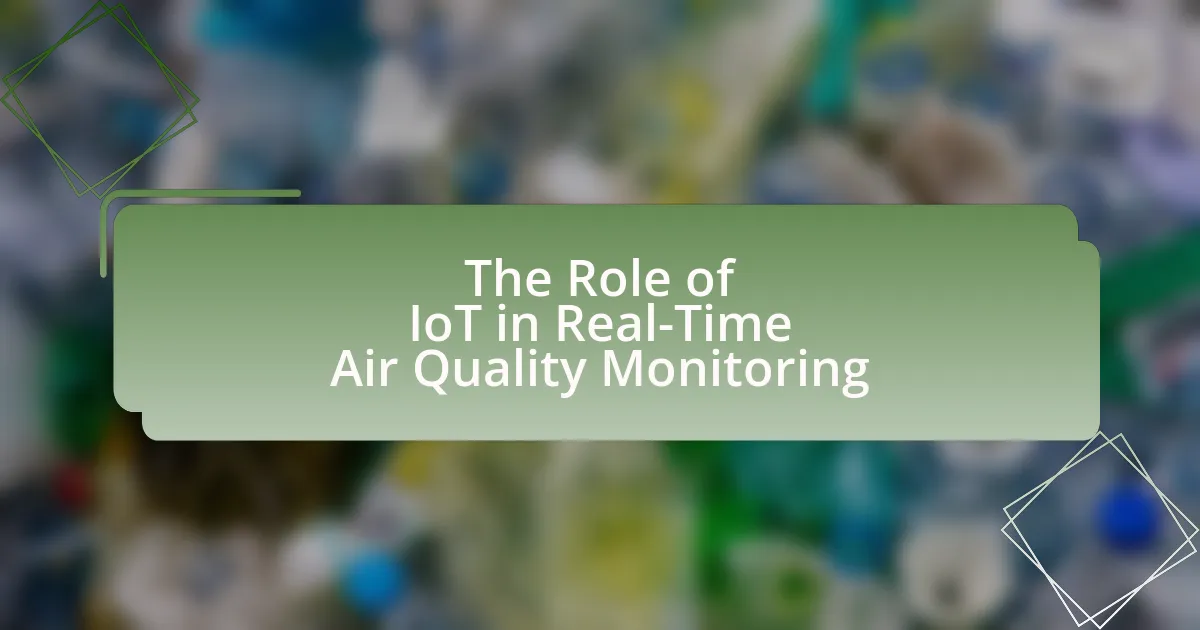The article focuses on the role of the Internet of Things (IoT) in real-time air quality monitoring, highlighting how interconnected sensors collect and transmit data on pollutants such as particulate matter and nitrogen dioxide. It discusses the key components of IoT systems, including sensors, communication networks, and data processing units, which work together to provide accurate and timely insights into air quality conditions. The importance of real-time monitoring for public health, the benefits of IoT technology in enhancing data accuracy and reliability, and the challenges associated with its implementation are also examined. Additionally, the article explores future trends in IoT for air quality monitoring, including the integration of advanced sensor technologies and machine learning, emphasizing the potential for improved urban planning and public health responses.
What is the Role of IoT in Real-Time Air Quality Monitoring?

The Internet of Things (IoT) plays a crucial role in real-time air quality monitoring by enabling the deployment of interconnected sensors that continuously collect and transmit air quality data. These sensors measure pollutants such as particulate matter, nitrogen dioxide, and ozone, providing immediate insights into environmental conditions. For instance, a study published in the journal Environmental Science & Technology highlighted that IoT-based monitoring systems can detect air quality changes within minutes, allowing for timely public health responses. This capability enhances urban planning and policy-making by providing accurate, real-time data that informs decisions aimed at improving air quality and protecting public health.
How does IoT technology facilitate real-time air quality monitoring?
IoT technology facilitates real-time air quality monitoring by deploying interconnected sensors that continuously collect and transmit data on air pollutants. These sensors, often placed in various locations, measure parameters such as particulate matter, carbon dioxide, and volatile organic compounds, providing immediate insights into air quality conditions. For instance, a study by the World Health Organization indicates that real-time data from IoT devices can help identify pollution hotspots and inform public health responses, thereby enhancing community awareness and safety.
What are the key components of IoT systems used in air quality monitoring?
The key components of IoT systems used in air quality monitoring include sensors, communication networks, data processing units, and user interfaces. Sensors detect various air pollutants such as particulate matter, carbon dioxide, and volatile organic compounds, providing real-time data on air quality. Communication networks, such as Wi-Fi, cellular, or LoRaWAN, transmit the collected data to centralized servers or cloud platforms for further analysis. Data processing units, often utilizing cloud computing, analyze the incoming data to generate actionable insights and trends. Finally, user interfaces, which can be mobile applications or web dashboards, present the analyzed data to end-users, enabling informed decision-making regarding air quality. These components work together to create an effective IoT system for monitoring air quality in real-time.
How do sensors and data transmission work in these IoT systems?
Sensors in IoT systems detect environmental parameters such as air quality, temperature, and humidity, converting these physical measurements into digital signals. These sensors utilize various technologies, including electrochemical sensors for gas detection and particulate matter sensors for measuring airborne particles.
Data transmission in these systems occurs through wireless communication protocols like Wi-Fi, LoRa, or Zigbee, enabling the collected data to be sent to cloud platforms or local servers for analysis. This process allows for real-time monitoring and data aggregation, which is essential for effective air quality management.
For instance, a study published in the journal “Sensors” highlights that IoT-enabled air quality monitoring systems can transmit data every few seconds, providing timely insights into pollution levels and enabling swift responses to environmental changes.
Why is real-time air quality monitoring important?
Real-time air quality monitoring is important because it provides immediate data on pollution levels, enabling timely responses to hazardous conditions. This capability is crucial for public health, as exposure to poor air quality can lead to respiratory diseases, cardiovascular issues, and other health problems. According to the World Health Organization, approximately 4.2 million premature deaths occur globally each year due to outdoor air pollution, highlighting the need for effective monitoring systems. By utilizing IoT technology, real-time monitoring can facilitate data collection and analysis, allowing authorities to implement measures to protect communities and improve air quality.
What health impacts are associated with poor air quality?
Poor air quality is associated with a range of significant health impacts, including respiratory diseases, cardiovascular problems, and adverse effects on mental health. Studies indicate that exposure to pollutants such as particulate matter (PM2.5) and nitrogen dioxide (NO2) can lead to conditions like asthma, chronic obstructive pulmonary disease (COPD), and heart attacks. For instance, the World Health Organization reports that air pollution is responsible for approximately 7 million premature deaths annually, highlighting its severe implications on public health. Additionally, research published in the journal Environmental Health Perspectives found that long-term exposure to air pollution is linked to cognitive decline and increased risk of neurological disorders.
How does real-time data improve public awareness and response?
Real-time data enhances public awareness and response by providing immediate access to critical information regarding air quality conditions. This immediacy allows individuals and communities to make informed decisions about their health and safety, particularly during pollution events. For instance, studies have shown that cities utilizing real-time air quality monitoring systems can alert residents to hazardous conditions, leading to a reduction in exposure and related health issues. Furthermore, real-time data facilitates timely governmental and organizational responses, enabling the implementation of measures such as issuing health advisories or mobilizing resources to mitigate pollution impacts.
What are the benefits of using IoT for air quality monitoring?

The benefits of using IoT for air quality monitoring include real-time data collection, improved accuracy, and enhanced public awareness. IoT devices can continuously gather air quality data from multiple locations, providing timely insights into pollution levels. This real-time monitoring allows for immediate responses to hazardous conditions, which can significantly reduce health risks. Additionally, IoT systems often utilize advanced sensors that offer higher precision compared to traditional monitoring methods. Studies have shown that cities employing IoT for air quality monitoring can detect pollution spikes more effectively, leading to better regulatory compliance and public health initiatives. Furthermore, the data collected can be shared with the public, fostering community engagement and encouraging proactive measures to improve air quality.
How does IoT enhance data accuracy and reliability?
IoT enhances data accuracy and reliability by utilizing a network of interconnected sensors that continuously collect and transmit real-time data. These sensors are strategically placed in various locations, allowing for comprehensive coverage and minimizing data gaps. For instance, in air quality monitoring, IoT devices can measure pollutants at multiple points, providing a more precise representation of air quality compared to traditional methods that rely on fewer sampling locations. Additionally, the integration of advanced algorithms and machine learning techniques in IoT systems helps filter out noise and anomalies in the data, further improving accuracy. Studies have shown that IoT-based air quality monitoring can achieve up to 90% accuracy in pollutant detection, significantly enhancing the reliability of environmental data.
What technologies contribute to improved data collection?
Technologies that contribute to improved data collection include Internet of Things (IoT) devices, cloud computing, and big data analytics. IoT devices, such as sensors and smart meters, enable real-time data gathering from various environments, enhancing the accuracy and timeliness of information. Cloud computing facilitates the storage and processing of large datasets collected from these devices, allowing for scalable data management and accessibility. Big data analytics tools process and analyze the vast amounts of data generated, providing insights that drive informed decision-making. These technologies collectively enhance the efficiency and effectiveness of data collection processes in various applications, including air quality monitoring.
How does real-time data analysis affect decision-making?
Real-time data analysis significantly enhances decision-making by providing immediate insights that allow for timely and informed actions. In the context of air quality monitoring, real-time data enables stakeholders, such as government agencies and environmental organizations, to quickly assess pollution levels and respond to hazardous conditions. For instance, a study by the World Health Organization indicates that timely data can reduce health risks by facilitating prompt public health advisories and interventions. This immediate access to relevant information empowers decision-makers to implement strategies that protect public health and improve environmental conditions effectively.
What cost savings can be achieved through IoT air quality monitoring?
IoT air quality monitoring can achieve significant cost savings by reducing health-related expenses and optimizing resource allocation. By providing real-time data on air quality, organizations can proactively address pollution issues, leading to lower healthcare costs associated with respiratory diseases, which account for billions in annual medical expenses. Additionally, IoT systems enable efficient energy use in buildings by adjusting ventilation based on air quality, resulting in reduced energy costs. A study by the World Health Organization indicates that improved air quality can lead to a 15% reduction in healthcare costs related to air pollution, validating the financial benefits of implementing IoT solutions for air quality monitoring.
How does IoT reduce the need for manual monitoring?
IoT reduces the need for manual monitoring by automating data collection and analysis through interconnected devices. These devices continuously gather real-time air quality data, eliminating the requirement for human intervention in monitoring processes. For instance, IoT sensors can detect pollutants and transmit data to centralized systems, allowing for immediate analysis and response. This automation not only increases efficiency but also enhances accuracy, as studies show that automated systems can provide more consistent data than manual methods, which are prone to human error.
What are the long-term financial benefits for municipalities?
Long-term financial benefits for municipalities include reduced operational costs, increased efficiency in resource management, and enhanced public health outcomes. By implementing IoT technologies for real-time air quality monitoring, municipalities can optimize their responses to pollution, leading to lower healthcare costs associated with air quality-related illnesses. For instance, studies have shown that improved air quality can reduce healthcare expenditures by up to 30% in urban areas. Additionally, municipalities can save on maintenance and operational costs by utilizing data analytics to predict and prevent infrastructure failures, ultimately leading to more sustainable budget management.
What challenges are associated with IoT in air quality monitoring?

The challenges associated with IoT in air quality monitoring include data accuracy, connectivity issues, and security vulnerabilities. Data accuracy is compromised due to the variability in sensor quality and calibration, which can lead to inconsistent readings. Connectivity issues arise from the reliance on stable internet connections, which may not be available in remote or densely populated areas, affecting real-time data transmission. Security vulnerabilities pose risks as IoT devices can be susceptible to hacking, potentially leading to data breaches or manipulation of air quality data. These challenges hinder the effectiveness and reliability of IoT systems in monitoring air quality.
What are the technical challenges in implementing IoT systems?
The technical challenges in implementing IoT systems include issues related to connectivity, data management, security, and interoperability. Connectivity challenges arise from the need for reliable network infrastructure to support numerous devices transmitting data in real-time. Data management challenges involve handling large volumes of data generated by IoT devices, requiring efficient storage and processing solutions. Security challenges are critical, as IoT systems are vulnerable to cyberattacks, necessitating robust security protocols to protect sensitive information. Interoperability challenges stem from the diverse range of devices and platforms, which must work seamlessly together to ensure effective communication and functionality. These challenges are well-documented in industry reports, such as the “IoT Security Foundation’s Best Practice Guidelines,” which highlight the importance of addressing these issues for successful IoT deployment.
How do connectivity issues affect data transmission?
Connectivity issues significantly disrupt data transmission by causing delays, data loss, and reduced reliability. When devices in an Internet of Things (IoT) network experience connectivity problems, the flow of data from air quality sensors to monitoring systems can be interrupted, leading to incomplete or outdated information. For instance, a study by the International Telecommunication Union indicates that network latency can increase by up to 50% during connectivity disruptions, which directly impacts the timeliness of data reporting in real-time applications. Additionally, packet loss rates can rise, resulting in critical air quality data being missed, which undermines the effectiveness of monitoring efforts.
What security concerns arise with IoT air quality monitoring?
IoT air quality monitoring systems face several security concerns, primarily including data privacy, unauthorized access, and device vulnerabilities. Data privacy is a significant issue as these systems collect sensitive information about environmental conditions, which could be exploited if intercepted by malicious actors. Unauthorized access can occur if proper authentication measures are not implemented, allowing intruders to manipulate or disable monitoring devices. Additionally, device vulnerabilities arise from inadequate security protocols, making IoT devices susceptible to hacking, which can lead to false data reporting or system failures. These concerns highlight the need for robust security measures in the deployment of IoT air quality monitoring systems.
How can these challenges be addressed?
Challenges in real-time air quality monitoring using IoT can be addressed through the implementation of advanced sensor technologies, data analytics, and collaborative frameworks. Advanced sensors enhance accuracy and reliability in detecting pollutants, while data analytics can process large datasets to identify trends and anomalies in air quality. Collaborative frameworks involving government agencies, private sectors, and communities can facilitate resource sharing and improve response strategies. For instance, a study by the World Health Organization indicates that integrating IoT solutions with existing environmental monitoring systems can lead to a 30% improvement in data accuracy and timeliness.
What best practices can be implemented for secure IoT systems?
To secure IoT systems, best practices include implementing strong authentication mechanisms, ensuring data encryption, and regularly updating firmware. Strong authentication, such as multi-factor authentication, prevents unauthorized access, while data encryption protects sensitive information during transmission and storage. Regular firmware updates address vulnerabilities and enhance security features, as evidenced by the 2021 Cybersecurity & Infrastructure Security Agency report, which highlighted that 85% of IoT breaches were due to unpatched vulnerabilities. Additionally, network segmentation can limit the impact of a breach by isolating IoT devices from critical systems.
How can stakeholders collaborate to improve system reliability?
Stakeholders can collaborate to improve system reliability by establishing clear communication channels and sharing data insights. Effective collaboration involves regular meetings to discuss system performance, identifying potential issues, and jointly developing solutions. For instance, in the context of IoT in real-time air quality monitoring, stakeholders such as government agencies, technology providers, and community organizations can share real-time data on air quality metrics, enabling timely responses to pollution events. Research indicates that collaborative data sharing can enhance predictive maintenance and reduce system downtime, thereby increasing overall reliability.
What are the future trends in IoT for air quality monitoring?
Future trends in IoT for air quality monitoring include the integration of advanced sensor technologies, enhanced data analytics, and increased use of artificial intelligence. Advanced sensors will provide more accurate and real-time data on pollutants, while data analytics will enable better interpretation of air quality trends. The incorporation of artificial intelligence will facilitate predictive modeling, allowing for proactive measures to improve air quality. According to a report by MarketsandMarkets, the air quality monitoring market is expected to grow from $4.4 billion in 2020 to $6.5 billion by 2025, indicating a significant investment in IoT technologies for this purpose.
How is machine learning being integrated into air quality monitoring systems?
Machine learning is being integrated into air quality monitoring systems by enhancing data analysis and predictive modeling capabilities. These systems utilize algorithms to process large datasets from various sensors, enabling real-time assessment of air quality levels and the identification of pollution sources. For instance, machine learning models can analyze historical air quality data alongside meteorological information to forecast pollution trends, improving response strategies. Research has shown that such integration can increase the accuracy of air quality predictions by up to 30%, as demonstrated in studies published in journals like Environmental Science & Technology.
What role will smart cities play in advancing IoT air quality initiatives?
Smart cities will significantly enhance IoT air quality initiatives by integrating advanced sensor networks and data analytics to monitor and manage air pollution in real-time. These urban environments leverage IoT technology to deploy a multitude of air quality sensors that collect data on pollutants, enabling immediate responses to deteriorating air conditions. For instance, cities like Barcelona and Singapore have implemented IoT systems that provide real-time air quality information, allowing for timely public health advisories and targeted interventions. This proactive approach not only improves public awareness but also informs policy decisions aimed at reducing emissions and enhancing urban living conditions.
What practical tips can be applied for effective IoT air quality monitoring?
To achieve effective IoT air quality monitoring, implement a multi-sensor approach that utilizes various types of sensors to capture a comprehensive range of air quality parameters, such as particulate matter, volatile organic compounds, and carbon dioxide levels. This method enhances data accuracy and provides a more complete picture of air quality conditions. Additionally, ensure that the sensors are calibrated regularly to maintain precision, as studies indicate that uncalibrated sensors can yield misleading data, potentially affecting decision-making processes. Furthermore, integrate real-time data analytics to process and visualize the collected data, enabling timely responses to air quality changes. Research shows that real-time analytics can improve public health outcomes by facilitating immediate action in response to pollution spikes. Lastly, establish a robust communication network to ensure reliable data transmission from sensors to the cloud, as connectivity issues can lead to data loss and hinder effective monitoring.

Leave a Reply